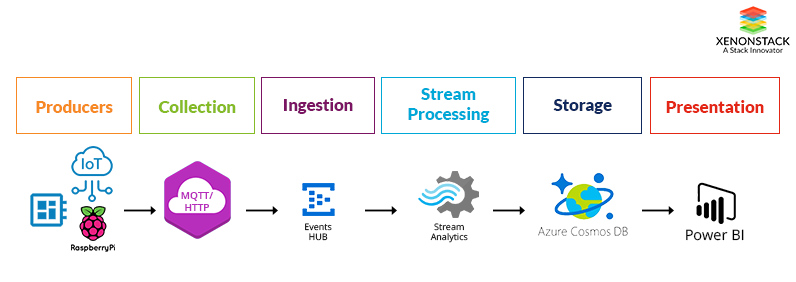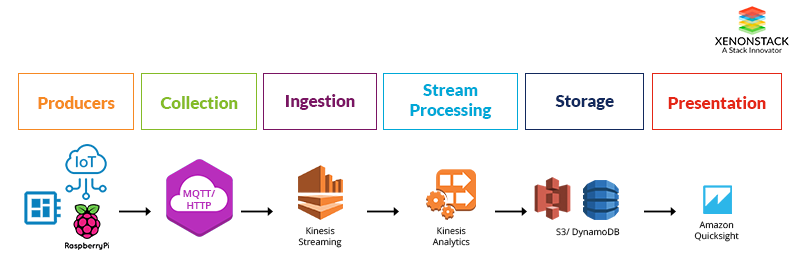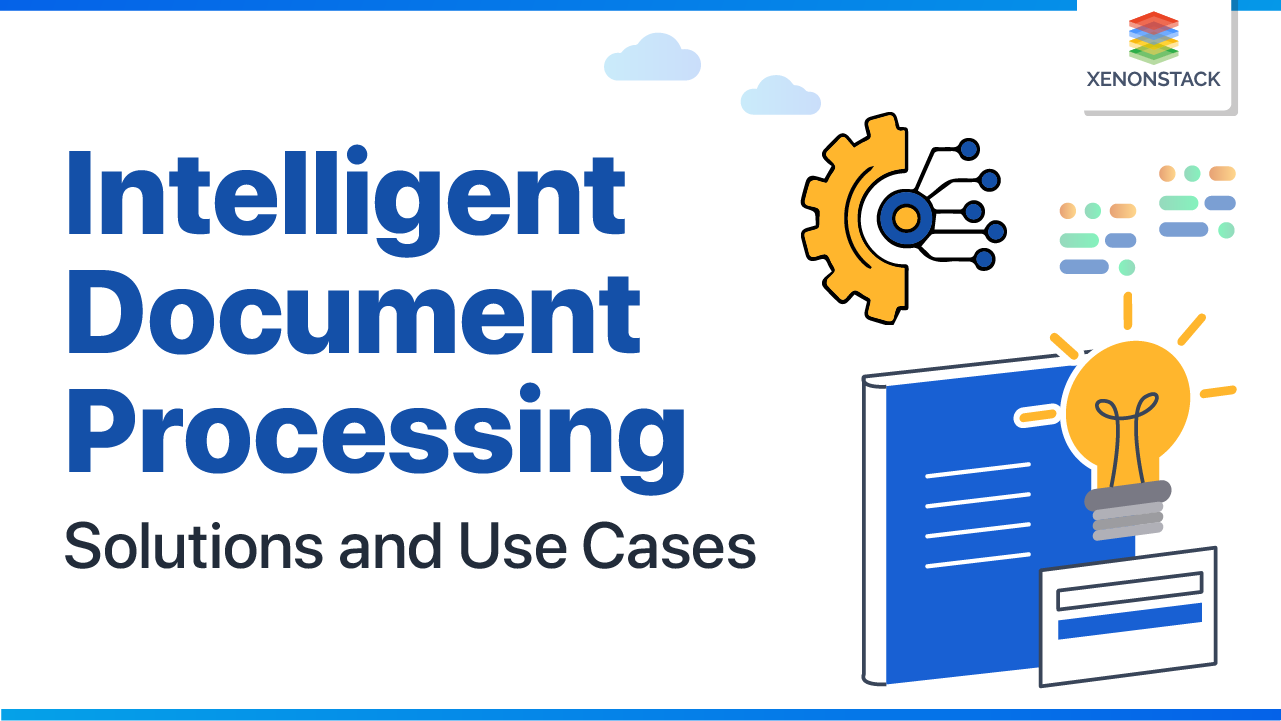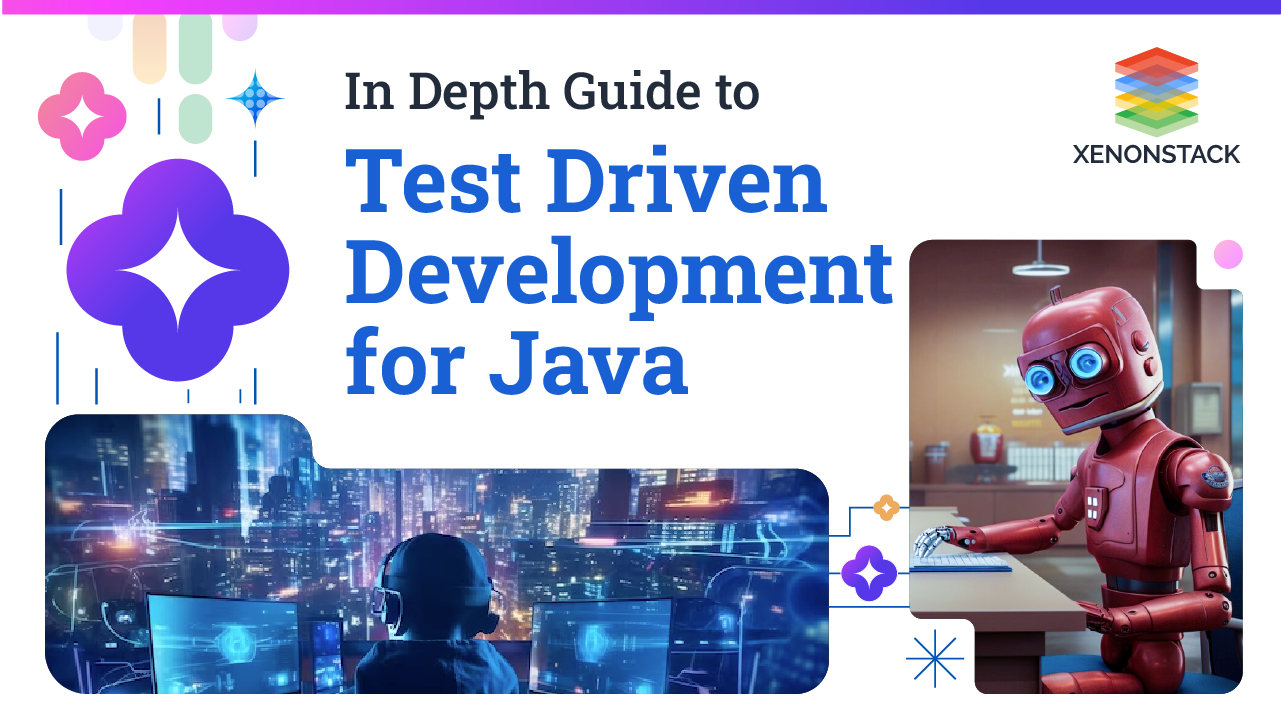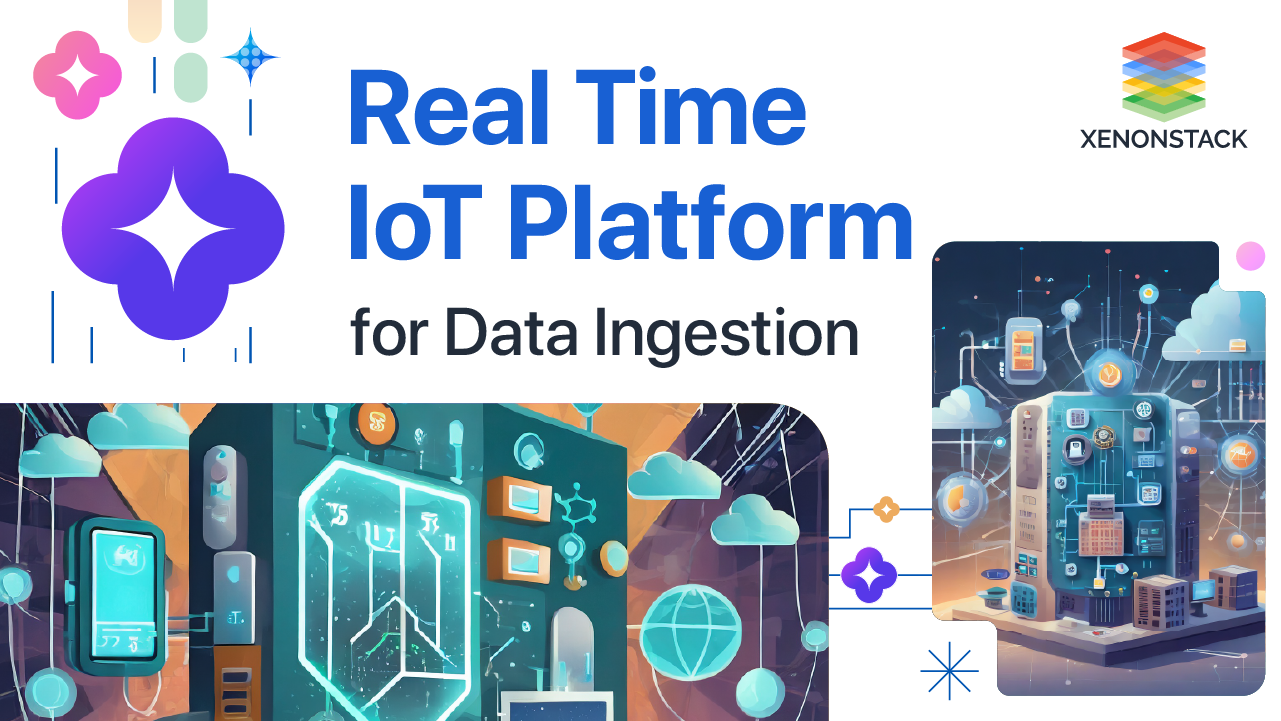
Which protocol is most widely used in IoT Analytics?
The below mentioned protocol are most widely used:
1. MQTT
-
MQTT is an efficient publish/subscribe protocol ideal for low bandwidth or unreliable network conditions, frequently utilized for remote sensor data collection.
-
The MQTT broker serves as a centralized communication point where clients publish and subscribe to topics to exchange messages.
2. CoAP
-
The Constrained Application Protocol (CoAP) is designed for simple, constrained devices and facilitates web based, RESTful interactions using familiar methods like GET, PUT, POST, and DELETE.
-
It is particularly well suited for constrained networks and power limited IoT devices.
3. AMQP
-
AMQP (Advanced Messaging Queuing Protocol) is an open standard for passing messages in between applications and organizations. It connects system, provides business processes with the information they need.
4. HTTP
-
This is the standard protocol for web services and still is used in its solutions. The most popular architectural style, called RESTful, is widely used on mobile and web applications and must be considered in IoT Solutions.
5. DDS
-
DDS stands for Data Distribution Service, which is a standard for real time IoT analytics and scalable and high-performance machine-to-machine communication. DDS can be deployed in both low-footprint devices and on the cloud as well.
-
With a Humancentric, sustainable and Resilient Industry 5.0 strategy for empowering connected IoT Solutions AI-powered Robots. Explore our IoT Application Development Services.
IoT Architecture on Different Platforms
1. Xenonify IoT Architecture
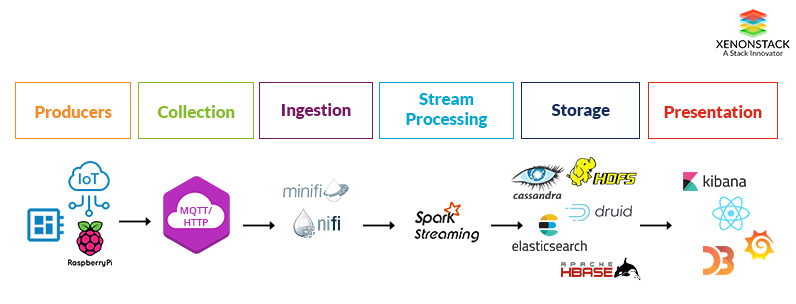
- Data Collection and Ingestion - This will be the first step in data handling from the IoT device. We have different options to collect data from the sensors. In the upcoming paragraph, we are going to discuss data ingestion using a different platform.
-
Using Apache NiFi - Apache MiNiFi, a subproject of Apache NiFi, can be deployed on the Raspberry Pi for lightweight and resource-efficient data collection. With MiNiFi, data from sensors can be collected and routed to Apache NiFi. From there, the data can be further routed to multiple desired destinations. The second method involves directly ingesting data from the MQTT broker and routing it to multiple destinations as needed. To accomplish this, we must design a data flow pipeline using various Apache NiFi processors.
-
Using Stream Sets - By Using StreamSets Data Collector Edge StreamSets data collector Edge is an ultralight agent for the IoT, which collects the data and sends it to the stream sets. The second method involves direct ingestion of data from the MQTT broker and routing it to multiple destinations as needed. To achieve this, we need to design a data flow pipeline using various StreamSets processors.
-
Data Processing - Xenonify provides you with a platform that you can use to build your own IoT analytics platform for the data collected from the sensor. Apache Spark is being used by Xenonify at the data processing stage. The speed of the data stream can also vary according to the time. So, Our Data Pipeline should be able to handle data of any size and at any velocity. The platform should be intelligent enough to scale up and down automatically according to the load on the data pipeline.
-
Data Storage - Xenonify offers you multiple data storage options, which include HBase, HDFS, ElasticSearch, and Druid as the TimeSeries database.
-
Presentation - After the process, the most important part is the visualization of the data. Xenonify offers a custom dashboard for the visualization of the data. We can build our dashboard by using Kibana and Grafana. We can also build our custom dashboard using React JS and D3.JS.
2. Google IoT Architecture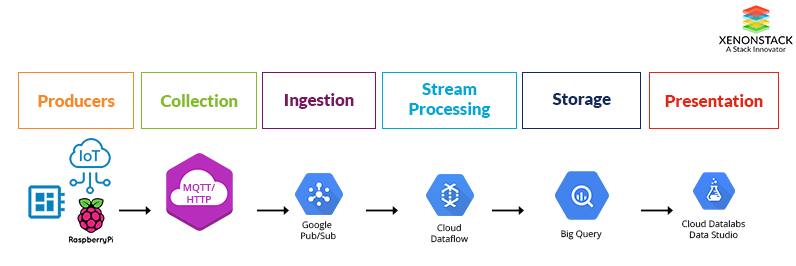
- Data Collection and Ingestion - Devices send data to Google Cloud IoT Core using secure protocols such as MQTT or HTTP. Cloud IoT Core is then responsible for managing the device identities and ensuring secure device connections.
-
Message Routing - Cloud Pub/Sub is utilized to collect and distribute IoT data. It acts as a messaging middleware that can handle massive streams of messages in a realtime, durable, and scalable manner.
-
Data Processing - Cloud Dataflow analyzes the ingested data in realtime. It allows for the transformation, aggregation, and analysis of data streams, effectively handling both batch and stream processing.
-
Data Storage and Analytics - Processed data is then stored in BigQuery, Google's fully managed, petabyte-scale data warehouse, which enables SQL queries and provides a robust analytics solution.
-
Data Visualization - For visualization and insights, Cloud DataLab or Google Data Studio can be used to create interactive dashboards and reports that can help businesses make data-driven decisions.
-
Integration with Advanced Services - The architecture can be enhanced with machine learning capabilities using Cloud Machine Learning Engine or TensorFlow to gain predictive insights from IoT data.
3. Microsoft Azure IoT Architecture
-
Data Collection and Ingestion - Azure IoT Hub allows devices to securely connect and send data using protocols like MQTT, AMQP, and HTTP. IoT Hub acts as the central message hub for bidirectional communication between IoT applications and the devices it manages.
-
Stream Processing - Azure Stream Analytics processes data in real time, analyzing and transforming data as it arrives, enabling insights and actions to be derived from the device data streams.
-
Data Storage - The transformed data can be stored in Azure Cosmos DB, a globally distributed, multimodel database service for managing data at scale.
-
Data Integration and Transformation - Data Factory can be used to orchestrate and automate data movement and transformation, preparing data for analysis or machine learning.
-
Data Visualization - Power BI connects to Azure Cosmos DB or other data sources to create interactive visualizations and business intelligence capabilities.
-
Advanced Analytics - Azure includes advanced analytics tools like Azure Machine Learning and Azure Databricks, which can be utilized to build sophisticated analytical models and gain deeper insights from IoT data.
4. AWS IoT Architecture
AWS IoT provides a robust framework to handle IoT analytics, allowing for the collection, ingestion, processing, storage, and presentation of IoT data. Here is a detailed explanation structured in points.
-
Data Collection and Ingestion - AWS IoT Core acts as the initial entry point for IoT data. Devices connected to AWS IoT Core can securely communicate using MQTT, WebSockets, or HTTPS protocols. This service ensures secure and scalable data collection, capable of supporting billions of devices and managing trillions of messages effectively.
-
Stream Processing - Once data is ingested, AWS IoT Analytics can be utilized for stream processing. It provides capabilities for time series data analysis, real-time dashboards, and virtual alarms based on machine learning models.
-
Data Storage - AWS IoT Analytics also allows for the seamless storage of IoT data. The service supports storing data in a time series format, which is ideal for analyzing and understanding device data over periods.
-
Data Enrichment and Transformation - During processing, data can be enriched with other sources of information, adding context to the raw data, which enhances the analytics. Data transformation tools within AWS IoT Analytics enable the conversion of the raw data into a format suitable for querying and analysis.
-
Presentation and Visualization - For visualization, AWS QuickSight can be integrated to present the analyzed data through interactive dashboards. This offers insights to end users, allowing for data-driven decision-making.
-
Integration with Other AWS Services - AWS IoT Analytics can be easily integrated with other AWS services such as Amazon S3 for storage, AWS Lambda for executing custom business logic, and Amazon QuickSight for visualization.
Real-Time Data Processing Technologies
Technologies and Methodologies
-
Real-time data processing may employ stream processing engines such as Apache Flink or Apache Storm, which are capable of handling high throughput and low-latency data streams.
-
These engines support complex event processing, event time windowing, and stateful computations, which are crucial for IoT analytics.
New Developments in IoT Analytics
Emerging Technologies
-
Incorporating edge computing into IoT architectures enables data processing closer to its origin, substantially reducing latency.
-
Artificial Intelligence and machine learning models are increasingly being deployed directly on IoT devices for tasks like predictive maintenance, enabling smarter and faster decision-making.
The Key use cases of IoT Analytics
1. Healthcare
IoT analytics enable remote patient monitoring by analyzing data from wearables and sensors, assisting healthcare professionals in tracking patient adherence to treatments and adjusting care plans in realtime.
2. Industries
In manufacturing, IoT analytics facilitate predictive maintenance of machinery, using sensor data to predict and prevent equipment failures before they occur.
3. Smart Transportation
Real-time analytics help optimize delivery routes, monitor fleet performance, and quickly respond to delays, thus improving logistics and reducing traffic congestion.
4. Smart Retail
Retailers utilize IoT analytics for inventory management and predictive equipment maintenance, enhancing the shopping experience by ensuring product availability and streamlined operations.
5. Smart Buildings
IoT analytics contribute to energy management and automated building systems, creating a comfortable and productive environment through smart heating, cooling, and space utilization.
6. Smart Agriculture
Farmers leverage IoT-driven data for soil moisture and nutrient sensing, enabling precise water usage and plant growth management for improved agricultural outcomes.
Holistic Approach
Real-Time Streaming Analytics Solutions for Enterprises & Startups helps them to accelerate their business growth for enhanced productivity. To know more about the enterprise IoT Analytics platform, you are advised to go through the below steps:
-
Read our Use Case based on IoT Analytics Platform on Google Cloud.
-
Know more about IoT Platform for Smart Farming.
-
Explore more about Real Time Analytics Use Cases.

